The largest concentration of public art in Idaho can be viewed at the WaterShed.
The WaterShed’s messages are emulated through the captivating works of art in and around the center. In 2001 Boise City Council passed a landmark "Percent-for-Arts" ordinance, committing up to 1.4% of eligible municipal capital projects for public art. Through this fund, local, regional, and national artists have captured iconic and symbolic messages about our watershed. The Boise City Public Art Program supports an enriched and thriving arts community through the integration of a diverse collection of works of art and programming. We also offer art and science programming for children and adults.
Enjoy the WaterShed public art StoryMap here.
The following works of art are featured:
Confluence
Amy Westover, 2008
The use of old pipes and parts from the water renewal facility junkyard take on a new life by delivering water for drinking and washing. These functional sculptures draw attention to the way in which our everyday lives depend upon the water renewal facility and how this facility can be seen as a work of art.
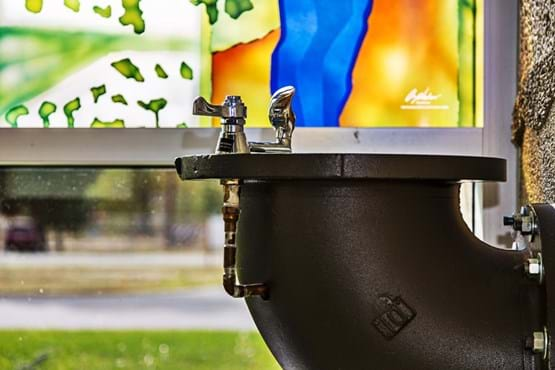
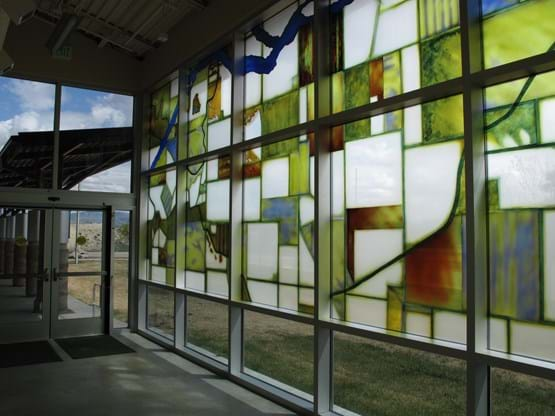
Windows Into Wet Land
Amy Westover, 2009
The Gallery glass windows look at our watershed through satellite infrared photography that maps how water is used on our land. Changing the colors and depicting neighborhoods, farmland and the Boise River, visitors get a sense of how the water intersects with the landscape and our lives.
Meander
Amy Westover, 2009
Metaphorically the river continues to flow, but as a visitor’s path leading into the exhibit hall. Made from a recycled rubber tire product, this floor design metaphorically recreates the Boise River flowing out of Lucky Peak Reservoir as it dissects the landscape.
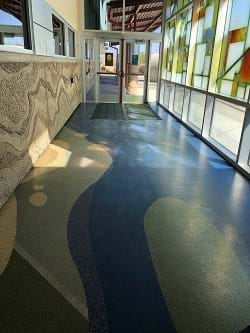
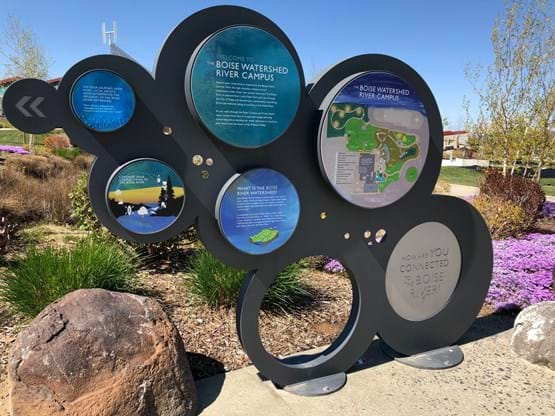
River Campus Interpretive Signage
Stephanie Inman and Ken McCall, 2016
The life cycle of water inspired the vibrantly colored, circular signs that dot the campus on your journey. Bubbles, ripples, rings, droplets, and swirling currents also appear as you explore the WaterShed River Campus.
Headwaters
Matt Grover, 2016
This three-sided, triangular sculpture represents the elements of the headwaters: snow water equivalent within the snowpack, stream flow rates, and the ruggedness of the terrain wherein it lies. The three main Boise River tributaries are fed by runoff, which is influenced by the snow water equivalent (SWE) within the snowpack. Each stainless steel slice represents one half of a month of the water year, starting with October and ending with September, and the thickness of the slices are proportionate to one another by how much potential water is in the snowpack at any given time.
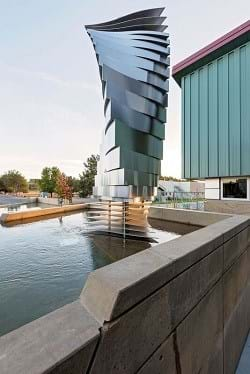
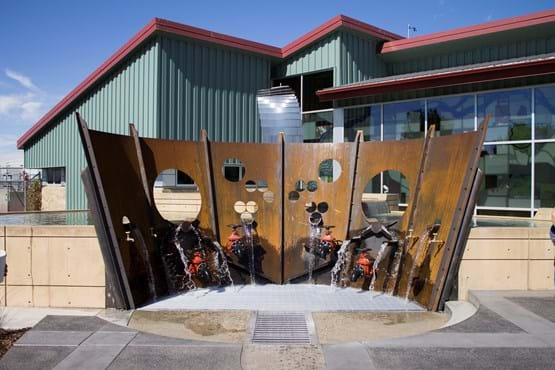
Fluxion
Byron Folwell, 2016
This interactive sculpture is composed of three distinct parts: the cast concrete reservoir, representing Lucky Peak Reservoir; the interactive steel dam sculpture; and the spillway, representing the Boise River. The elements collectively tell the story of the Treasure Valley’s most essential resource: water.
Mapping Infrastructure: Fire Hydrants, Sewer lines and Sewer Manholes Tree Grates
Amy Westover and Dwaine Carver, 2016
The plaza represents the City of Boise with its sharp angles, industrial materials, and urban feel. Boise leads the region in population density and corresponding water use. The maps around the base of the trees depict water and sanitation networks that provide people in Boise with fresh water and waste disposal systems.
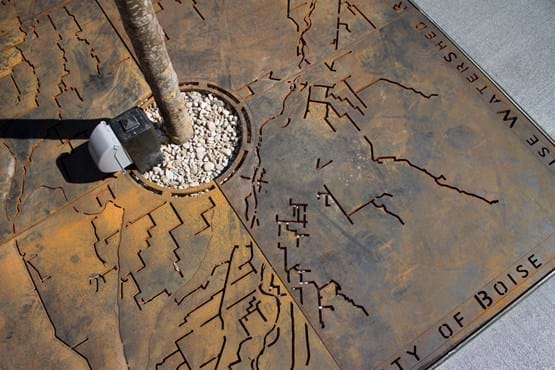
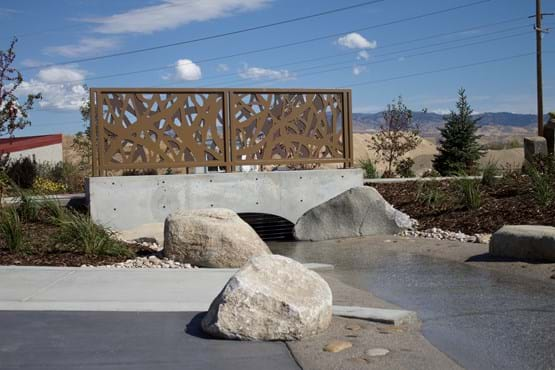
Beaver Dam
Ken McCall, 2016
The organic patterns found in the railings take inspiration from beaver dams. The layered sticks, branches and trees create architectural wonders along our waterways. Some people mistake beaver activity as harmful, but the dams beavers build actually create natural reservoirs and wetland habitats that many species call home. Beaver ponds also filter water and recharge our aquifer.
A Perfect World
Reham Aarti, 2016
This expansive mosaic consists of over 270,000 individual industrial glass tiles that the artist placed by hand. Perfect World depicts the impact that land surface use has on the soil and water below. By understanding these dynamics, we can become more aware of how important it is to conserve water individually and collectively.
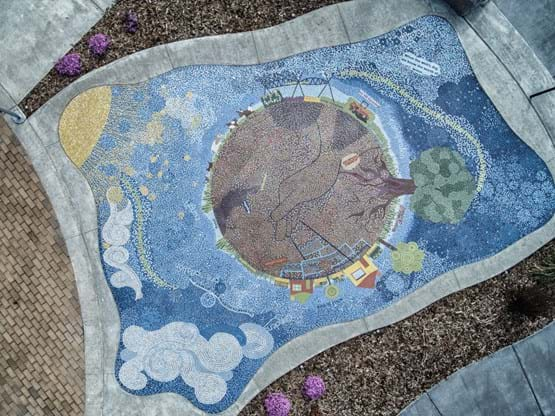
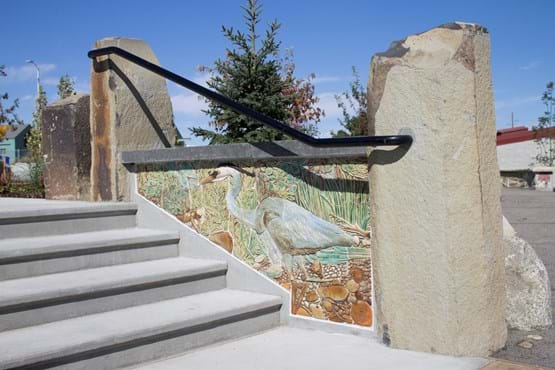
Wading In
Michael Anderson, 2016
Basalt and concrete formations represent the banks of the Boise River created throughout eons of erosion. The inner lining of ceramic relief tiles depict a variety of aquatic life that call the Boise River home. As you travel along the Boise River walk, you may see some aquatic species such as trout, whitefish, mink and beaver. The Boise River warms up as it approaches the Snake River, and you may see catfish, bass, and grasses on the bank. Finally, toward the end you will find creatures that live above water and around the banks, including herons, otters, and dragonflies.
H2O and Wind Translator
Patrick Zentz, 2009
These three exterior sculptures act as a kinetic instrument system that read and translate elements of the immediate environment into sound. The wind-sensitive instruments are visually based on the water molecule (H2O). Each apparatus rotates around the "O". The "H's", which are really Savonius windmills, spin relative to wind speed. The individual elements are designed so that their motions are encoded electronically. That information is then used to activate acoustic instruments within the interior of the WaterShed lobby.
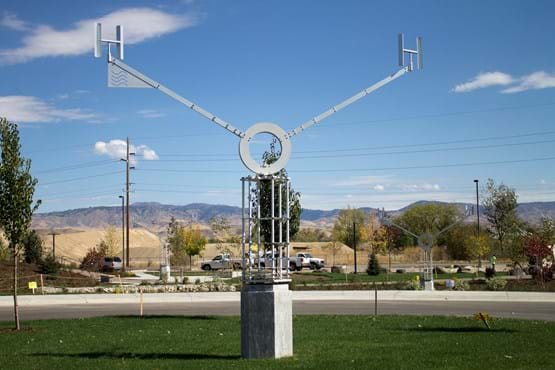
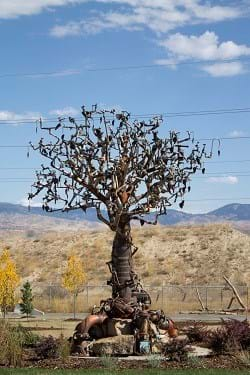
Enviroguard Pipe Tree
Irene Deeley, 2008
The pipe tree sculpture recognizes recipients of the City’s EnviroGuard Sustainability Award. The honor is presented to Boise businesses, non-profits, and individuals for their innovation and commitment to environmental and economic sustainability. The sculpture is composed of salvaged household plumbing fixtures that the artist collected through a notice for public contribution, and industrial scraps the artist found in the treatment plant’s “bone yard.” Various pipes grow and twist from the ground around the trunk and branches, which terminate at faucets to represent our individual responsibility for sustainability. Each piece was recycled and re-integrated into the form of a tree to represent the relationship that can exist between businesses and the natural world if the right care is taken.
Rookery
Michael Anderson, 2019
The artist’s intent was to create a rookery of herons and cormorants utilizing the six columns of the shade structure as quazi-trees. He spent several springs watching the birds nest on locations along the Boise River near the WaterShed.
The birds nest on locations along the Boise River near the WaterShed. Additionally, he wanted to share the actions of the birds at different times in the nesting cycle to make them more useful for teaching.
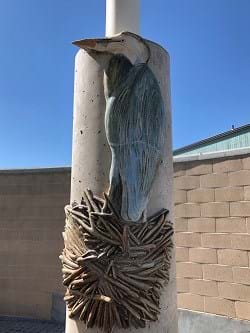

Waters Past
Amy Westover, 2008
The concrete wall on the Education Center building becomes a receptive surface itself recording the lines or rings left around a reservoir and drawing visitors’ attention to the presence or absence of water.
